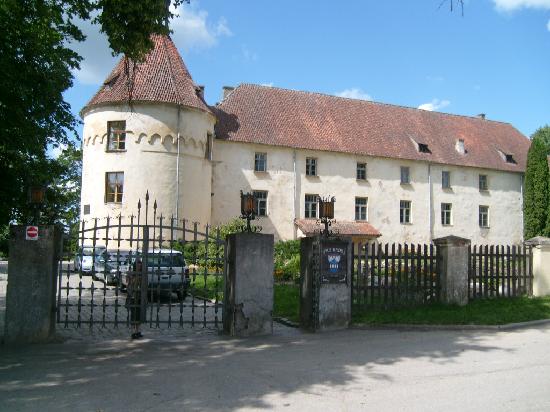

Location: Zemgale region Map
Constructed: 14th century
Tel. 6310 7082
Open 10am- 6pm Mon- Fri
Official site
Jaunpils Castle or Schloß Neuenburg in German is a medieval citadel in Zemgale region of Latvia It was constructed in 1311 by Master of the German branch of the Livonian Order, Gottfried von Roga. In the 15th century the order added a tower to improve the defences. Jaunpils Castle was intended to defend South border of Lithuania from the growing power of Moscow principality, but a threat came from the North. Swedish armies heavily damaged its military defences during Thirty Years' War. In the 17th century the castle lost its military significance and it was reconstructed as a manor house. It was badly damaged inn the Russian Revolution of 1905, but it was quickly fixed under supervision of architect Wilhelm Bockslaff. Today Jaunpils Castle is reconstructed and turned into a hotel.
Jaunpils Castle was first mentioned in
written sources in 1411 and was probably built in the second half of
the 14th century or even at the very beginning of the 15th century.
There is no documentary justification for the year 1301, often
mentioned in tourist booklets, as the year of construction of the
castle - at that time the Livonian Order was at war with the city of
Riga and it did not have the resources and time to build the castle.
In the 15th century, the castle fortifications were strengthened
and a massive round tower was built in the southeast corner. At the
beginning of the 16th century, Jaunpils became a place where old,
disabled brothers of the Livonian Order were accommodated.
In
1576, the castle was taken over by Matthias von der Reke, the last
commander of Dobele. His grandson Matthias Dietrich von der Reke
(1608-1652) rebuilt the castle, as a result of which the
fortification was transformed into the residence of the nobles,
including the construction of the third floor. Reke Castle belonged
to the beginning of the 20th century. They started breeding breeds
here, and this occupation in Jaunpils was inherited by later powers
until the end of the 20th century.
During the 1905
revolution, in 1906 the castle was burnt down, in 1907 it was
restored according to the design of V. Bokslaf, creating simplified
neo-baroque interiors. During the First World War, after the end of
the Kurzeme offensive in the autumn of 1915, Jaunpils Castle was
visited by the German Emperor Wilhelm II. From the 1920s to the
1960s, the castle housed livestock-related institutions. In the
1960s, the castle was rebuilt to suit the needs of the cultural
center.
Since 1991, the castle has been the property of the
municipality and is used for public purposes.
Description
Jaunpils Castle was covered on all sides by water barriers.
Nowadays, the filled moat is no longer visible.
The castle
was built of boulders, using bricks at the top of the walls. The
castle forms an irregular quadrangle measuring 41 x 30 meters. A
massive round tower with a diameter of 11.5 meters was built in the
15th century. In the Middle Ages, only the south-eastern and
south-western buildings of the castle were built, on the other two
sides the inner courtyard of the castle was covered by a protective
wall.
An interesting art monument is the bas-relief "Madonna
with Child" in one of the castle halls, most likely built in the
19th century. It is often believed that this bas-relief was created
in the 16th century.